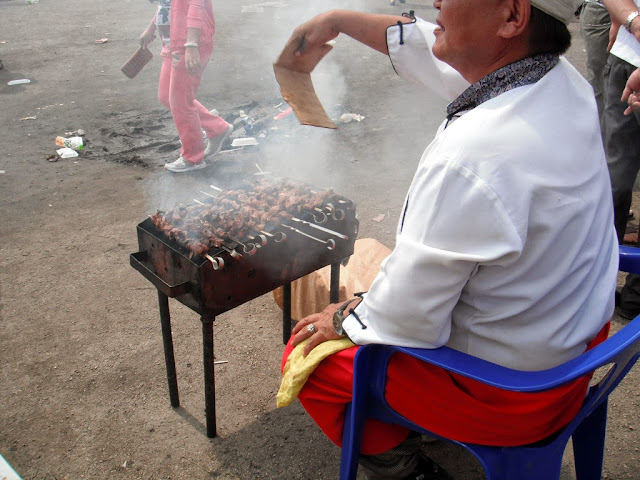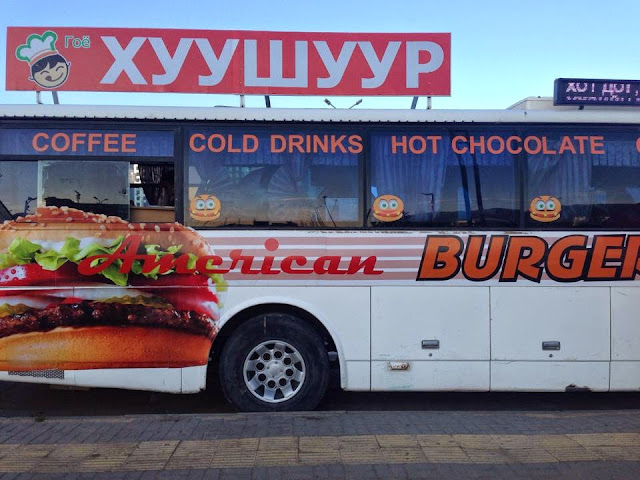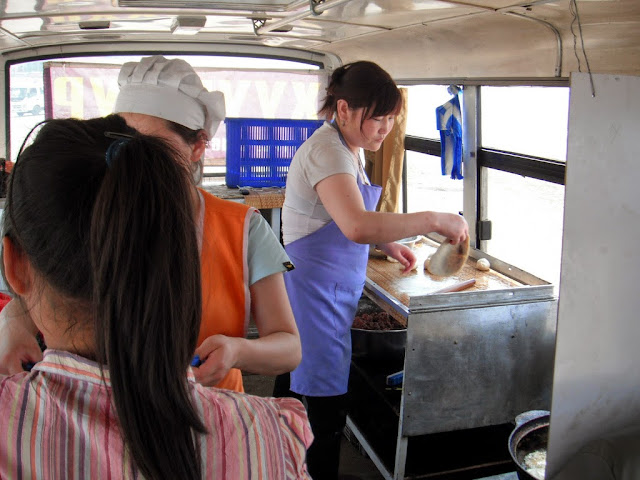Street Food in Mongolia
Wandering Educators: I saw this post on street food in Mongolia, and knew it would be a perfect match for your interests (and travels). I asked the UB Post if we could republish it; indeed as you can see, they said yes. The link to their site is at the bottom of the article - click through and explore this very interesting online newspaper, full of local culture and news. Be sure to explore the best sculptures selected at Ulaanbaatar Sculpture 2014, the art exhibitions, politics, events, and more. It's an excellent resource.
Street Food in Mongolia
During Naadam, floods of families and individuals prepare fresh khuushuur (a meat-filled fried pastry) in tents, kiosks, stalls, and gers for locals and foreigners hoping to grab a tasty street snack while viewing the colorful display of Mongolian sport.
But when the holiday fanfare dies down, ready-to-eat street food virtually disappears with it.
Ulaanbaatar is an unconventional scene for street food, a culinary culture of low-cost outdoor dining popular in cities and small towns across Asia. Perhaps the county’s underdeveloped roads have prevented a definitive outdoor food culture from emerging, or the brutal winters and traditional Mongolian dining etiquette, a conduct which considers eating in a public space rude. Although rural people in developing urban areas typically take stock in the informal food sector, playing a critical socioeconomic role for local communities, this has not been the case for Mongolia.
Naadam is the country’s only real glimpse of affordable outdoor public dining, and it’s a unique one. Sellers are generally educated, middle class families looking to make an extra buck, or area restaurants setting up special khuushuur stalls for Naadam. A family or group of friends may pool resources, like tables, chairs, an extra ger and stove, mixing bowls and other essentials, just to set up a khuushuur ger or tent. Some industrious families make khuushuur at home and send them to Naadam festival grounds in insulated coolers to be sold directly to non-food vendors who are unable to leave their stalls.

Khuushuur, prepared quickly and to order and best eaten when hot, are sold during Naadam at wrestling stadiums, parks, and horse racing fields in the provinces and capital, as per Mongolian tradition. For many, khuushuur is one of the most important aspects of the annual festival. Naadam even has its own special khuushuur, a gigantic, disc shaped variation that’s rarely found anywhere else but festival grounds. “I’m just going to go to Central Stadium, buy some khuushuur and leave. That will be my Naadam,” laughed Chuulun, a resident of Ulaanbaatar. Khuushuur is the taste of Mongolian summer, even though it’s eaten year-round.
As reported in the UB Post’s special Naadam edition, 10,000,000 MNT was budgeted this year to keep government officials full on khuushuur during the holiday, and an estimated 6,000,000 khuushuur were eaten during Naadam. Yet, a study by the International Labour Organization (ILO) found that 17 to 20 percent of gross domestic product (GDP) in Mongolia is from the informal economy, of which street food vending is only a part.
On the surface, Ulaanbaatar has everything that would bring to life a booming street food culture: a densely populated capital, lots of pedestrians, community members in need of work after relocating from rural areas, and access to an abundance of cheap meat products. But Mongolia faces challenges in developing such a culture.
Roads
Street food implies food made, sold and eaten on the street. A 2009 report from the Ministry of Roads, Transportation Construction and Urban Development stated that there were 49,186 kilometers of road in Mongolia, 1,394 kilometers of which were paved. The availability of paved roads has risen since then, with over 1,800 kilometers of newly paved road being promised this year by Deputy Minister of Ministry of Roads and Transportation Kh.Yerjan in a “Development Hour” meeting held in June. While asphalt and sidewalks aren’t required for street food dining, they certainly help. A more geographically concentrated population helps as well, which UB has in spades. Pedestrians own the streets (despite the aggression of UB drivers), yet the city still doesn’t have a regional street food culture. Long term residents pop into their local guanz (cafeteria-style restaurants with simple national favorites) when they want a cheap and easy meal, but they order and eat indoors. Demand for delivery services is on the rise, but largely among a more affluent percentage of the population. People want faster food and convenience, but they aren’t looking to street food for solutions.
Weathering Winter
A trip to the National Garden Park, where UB residents can go to enjoy the surrounding mountain view, cycle, and gather for special events, is revealing. Kiosks now line the main entrance to the park and people can be found selling beverages, snacks and ready to eat goods, including khuushuur, in the surrounding area. Thirty vendors were authorized to sell food during Naadam at National Garden Park, but their presence is a new development and recent rumors of a city-wide ban on street food vendors presents an unclear long-term future for these enterprising folk.
Bayarmaa, whose hometown is Ulaanbaatar, explained that harsh weather conditions, vending permits and sanitation concerns contribute to lack of business for street vendors: “Only during Naadam is street food common, when people buy the khuushuur, after that it is not so common, although some buy and sell barbequed meat in some place(s) or at train stations. This is because (in) the winter it is very cold, and in summer it is very hot, so this makes it hard for people to sell their products. Also, people are worried that the food is not clean. But we who have permission have clean food, the problem is those who don’t.”
Summer also brings enterprising herding families to the highway to set up roadside food gers. Travelers heading to summer homes, holiday family visits, and setting off for camping excursions can stop for airag (fermented mare’s milk) with the milked mares usually just outside the ger, khuushuur, or khorkhog and shorlog (actual Mongolian barbeque). Cars pull off the road, enter the ger to order and eat at small tables set up outside. Perhaps this summer tradition is the most indigenous representation of Mongolian street food, but they are a purely seasonal set up. Families move their camps and herds to run these small businesses along the highway for just a couple months out of the year, and as the warm weather and tourists fade, the gers disappear again into the hills to their fall and winter sites.

Cold weather doesn’t kill off street food in other parts of the world. Menus change based on the seasons and open stalls usually adapt with some weatherproofing, but the culture still lives. Roasted chestnut vendors in Seoul epitomize winter for some Koreans, the way that buuz is the taste of winter and Tsagaan Sar. Yet, as much time as Mongolians spend outdoors when it’s below freezing, buuz food trucks still aren’t parked at UB curbs.
Khuushuur is the only real contender in UB’s world of mobile food businesses, operational even during Mongolia’s long winters. The adaptation of large Korean tour buses into khuushuur gers on wheels can be spotted not only during the authorized Naadam run at the National Garden Park, but on the outskirts of the city. They serve khuushuur and beverages, nothing more, but the bus seats have been moved around and tables and counters are available to customers to dine-in, out of the cold.

Mongolian Manners
The general Mongolian attitude towards street food is not positive. Khongorzul, a visitor of the National Garden Park who was born in Ulaanbaatar, spoke about the Mongolian perception of street food, contributing to the lack thereof, “People in the city don’t want street food. We want food from restaurants. During Naadam we buy khuushuur, but even that is not reliable. At Central Stadium some tents are from restaurants, and we prefer that. Sometimes people use goat meat instead of mutton or beef because it is cheaper… Also, in the city it is so dusty and this makes it not clean maybe…. That is why we do not like street food.”
Mongolians frown on eating meals out in “public”, away from a table or out in the open, and there are numerous proverbs that warn against eating food too quickly. Walking and eating is another no-no, almost as rude as the refusal of food in a ger and as unfortunate as eating alone. Even at Naadam, it’s rare to see anyone but small children or tourists eating khuushuur as they walk and explore the festival grounds. These rules of etiquette are a cultural blow to street food’s prosperity here, but times are rapidly changing.
The formality, attention, and consideration offered to a guest being served food in a ger is found in only a handful of restaurants in Ulaanbaatar, and diners often pay much higher prices for such service than the average UB resident can afford. The hospitality of herding families has become iconic in Mongolian popular culture, captured in television commercials, music videos, and sold by tour companies around the city. UB’s city-dwelling Naadam festival attendees tap into this “traditional” spirit when they don deel for the festival, and buy tickets to watch games that are an everyday part of life in the countryside. What they aren’t comfortable with is the hygiene standards of a ger kitchen.
Future of Street Food In UB
Mongolia is a prime hunting ground for the analysis of changing cultural attitudes and adaptation. B.Enkhzaya, COO of Rosewood Cafe and Rosewood Kitchen + Enoteca, commented on public response to their summer outdoor dining series of pop-up cafes outside of Central Tower: “We have had a great response from our guests with our street cafe. We believe the secret is in making sure the quality and service do not falter just because it is street food. There is always a chance for businesses that create a unique concept and understand the fundamentals of service.”
Informal street vending has been shown to create an economic boost in terms of GDP and employment. According to the ILO, the informal sector’s contribution to GDP ranges from 13 percent in Mexico to 58 percent in Ghana, and from 48 percent in North Africa to 72 percent in sub-Saharan Africa in terms of employment, where statistics are available.
As more and more Mongolians spend time abroad, and as interest in foreign cuisines continues to grow, safe, regulated street food could take off in Ulaanbaatar. Mongolia’s own unique culinary culture and traditions shouldn’t be replaced with hot dog carts, taco trucks and takoyaki stands, but perhaps more innovations and economic opportunity will emerge for Mongolian cuisine.

Read more at http://ubpost.mongolnews.mn/?p=10646
Article by Michelle Borok and Margaux Maxwell, reprinted with permission
All photos courtesy and copyright UB Post



















